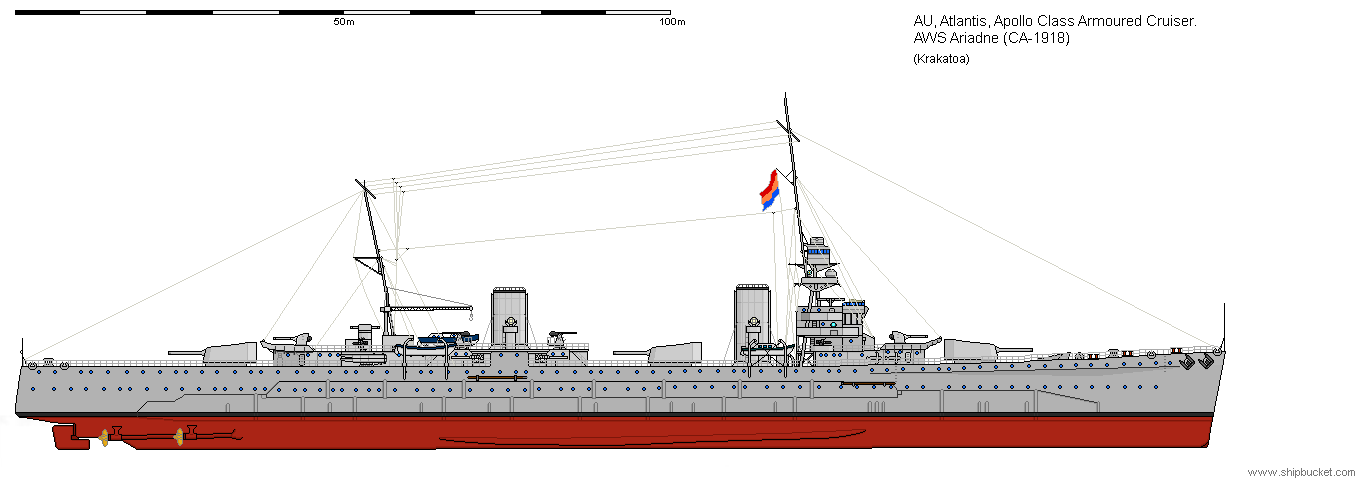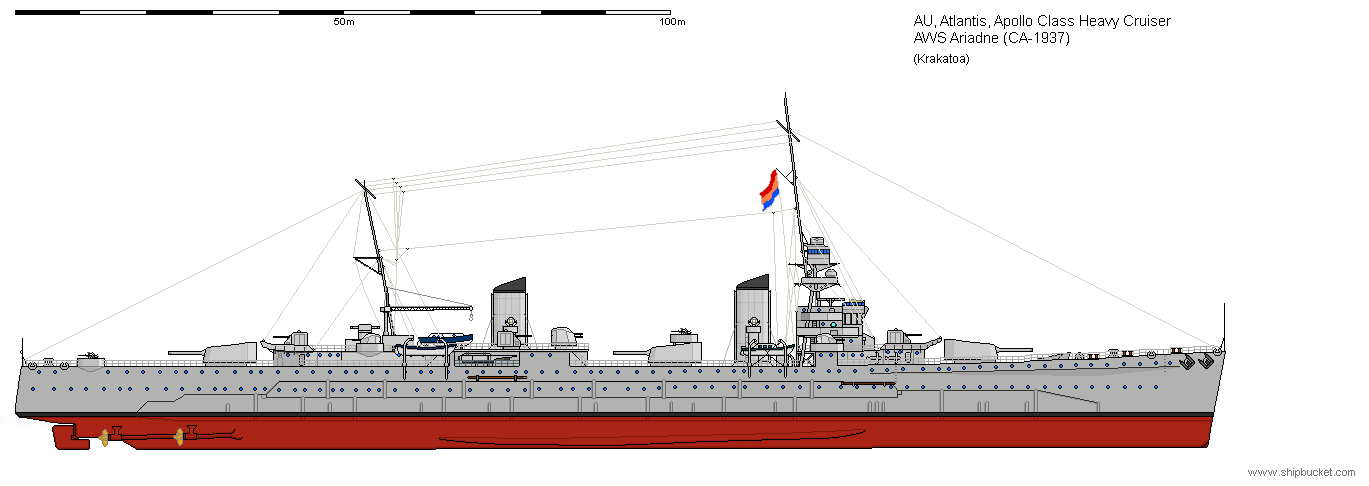Apollo Class Armoured Cruisers.
Return to Index page:
Return to
Atlantis Ship Page:
The large AMC's of the German Navy had shelled the coast of Atlantis but the
guard ships around the Atlantean coasts had not been fast enough to catch them.
A new class of cruiser was deemed necessary to protect the coasts and also be
able to range over the sea lanes as well. The 7.5" gun was viewed as the best
possible weapon for the task. Firing fast enough, with a large enough range, and
with a big enough shell to defeat anything except a capital ship. The hull was
made big enough to take a 90,000shp propulsion unit which pushed the ship along
at 33 knots in normal condition while at extreme full load of 13,500 tons the
ship still made 32 knots.
My thought with these ships were for it to be a class of 3 to replace the Erebus
class. Two would be completed as cruisers and the third would be the Chronos
light carrier.

The ships would be classed as Armoured Cruisers till the new rate of Heavy
Cruiser is brought about by the Washington Treaty.
Displacement: 10,000 tons normal, 13,500 tons full load.
Dimensions: 605 x 63 x 22
Machinery: oil fired, geared turbines, 90,000shp, 4 shafts.
Speed: 32 knots
Endurance: 11,000 miles at 14 knots
Armour: 5.5" belt (3" upper belt), 2.5" deck, 6"/4" turrets,
Armament:
9 x 7.5" (3x3)
6 x 5.5" (6x1)
4 x 4" AA (4x1)
4 x 2pd (4x1)
6 x 21" Torpedo tubes (2x3)
Crew: 715
AWS Apollo (1918)
AWS Ariadne (1918)

As rebuilt to 1937:
Displacement: 10,000 tons normal, 13,500 tons full load.
Dimensions: 605 x 63 x 22
Machinery: oil fired, geared turbines, 90,000shp, 4 shafts.
Speed: 32 knots
Endurance: 11,000 miles at 14 knots
Armour: 5.5" belt (3" upper belt), 2.5" deck, 6"/4" turrets,
Armament:
9 x 7.5" (3x3)
8 x 4" (4x2)
12 x 40mm (1x4 4x2)
6 x 25.4mm (3x2)
4 x 21" torpedoes
Crew: 715
AWS Apollo (1918)
AWS Ariadne (1918)
Service Record AWS Apollo.
1918 First
cruiser squadron at Demeter, used for coastal patrols and convoy cover from
Atlantis to Gibraltar. Service till wars end.
1921 Joins
International Squadron based on Singapore under League of Nations initiative to
reduce the threat of South East Asian Pirates. Two years of heat and misery
followed with the Apollo chasing the pirates from the sea to the coast and then
having to launch ships boats to chase the pirates into the coastal waterways and
mangrove swamps. Ambushes, point blank firefights and hand to hand combat. Like
the Hydra, every time a nest of Pirates was destroyed, two more nests seemed to
grow in their place.
1924 After a 6
month refit, Apollo rejoined the 1st cruiser Squadron. Their lot being patrols
and show the flag missions on the Atlantic sea lanes and in the Mediterranean
and Caribbean Seas.
1926 Both
Apollo and Ariadne are showing the flag in the Caribbean when they receive
orders to rendezvous at Kingston, Jamaica. On arrival, both ships are loaded
with supplies and equipment and are ordered to ports on the Caribbean coast of
Central America, which had been hit with a series of 7+ magnitude earthquakes
that had devastated the lands. Both ships are used as mobile generating stations
and go from port to port giving aid and succour for the next six months.
1927 Apollo
returns to 1st Cruiser Squadron after Caribbean odyssey. Back to the coastal and
long range patrols.
1929 Both
Apollo and Ariadne are dropped from the 1st Cruiser Squadron and join the 2nd
and 3rd Cruiser squadrons respectively, as flagships of four light cruisers.
1931-1936 with
breaks for refits Apollo continues as flagship of the 2nd Cruiser Squadron on
patrol duties.
1936 Taken in
hand for major refurbishment, returning to the fleet in 1937.
1937
Neutrality patrols with the International Squadron in Spanish waters.
1939 Outbreak
of war Apollo recalled from patrol to Demeter to join two ships of the Hesperus
class. Designated Force P, they are sent to the South Atlantic to hunt for the
Graf Spee.
Battle of the River Plate
- Commodore Harwood, deploys his three cruisers to intercept the Graf Spee and
contact is made just after 10am and both sides prepare for battle. The airwaves
are alive with sighting reports calling for assistance. Force P, is closest, 4
hours steaming away at 20+ knots. Force P had been considered too small to
tackle the Graf Spee by itself and the battleship Demeter had joined the
squadron. Cutting corners and following the continued stream of reports, Force P
roars toward the battle at best speed (30 knots). The reports tell the fortunes
of Commodore Harwood’s ships. Exeter is badly hit and forced to withdraw, on
fire and fighting bravely to survive. Ajax is sorely wounded, and with the
Achilles is trying to draw the Graf Spee toward Force P. Demeter slows enough
to fly off a seaplane, which reports back 5 minutes later with a true view of
the battle space. Admiral Smith aboard Demeter deploys his ships to best
advantage. Admiral Smith is mentally rubbing his hands, this is exactly what
Demeter had been designed and built for. Ten minutes later and the battle is in
sight, five minutes after that and the Graf Spee’s death arrives with the first
salvo of 16”shells. Graf Spee turns to run but the Demeter is faster, bigger,
better armed and armoured, it is just a matter of time. At 25,000 yards the
first 16” hit is achieved and the Graf Spee visibly slows. Further hits turn the
Graf Spee to a wreck. The range comes down to under 12,000 yards, point blank
range. But the German flag is still flying and Admiral Smith orders the Apollo
to close and finish the Graf Spee with torpedoes.
The above, while it follows a single ships first 20 years of service, parts of
it really need to be repeated for the other Atlantean ships also described,
Demeter, Ariadne, 2 Hesperus class cruisers. The way to do it is to eventually
have all ships service records completed, then another 'One ring' Timeline to
draw it all together. It is very possible to do this but it is whether the urge
can be found to do it. It is why GD and BB1987's 'walls' of text are worth
reading and correcting. The amount of time they have taken to produce their
backstories deserves your recognition. Being a two finger typist myself.
Producing my little 'wall' of text above took me two hours to type, and another
hour or two to research the various happenings, and dream up the rest.
Return to
Atlantis Ship Page: